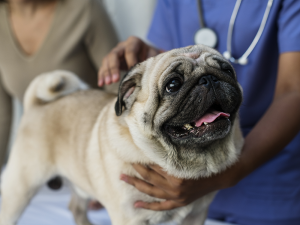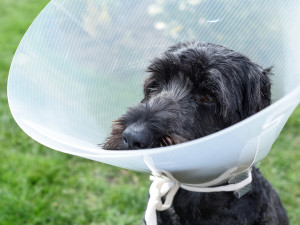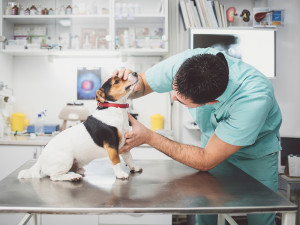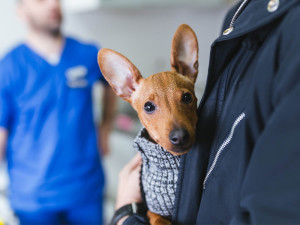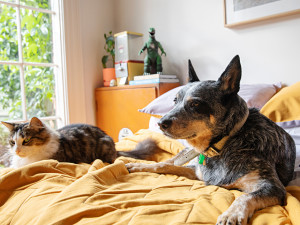How to Get a Head Start on Your Pet’s Health
Spot lumps, limps, and lethargy early on.
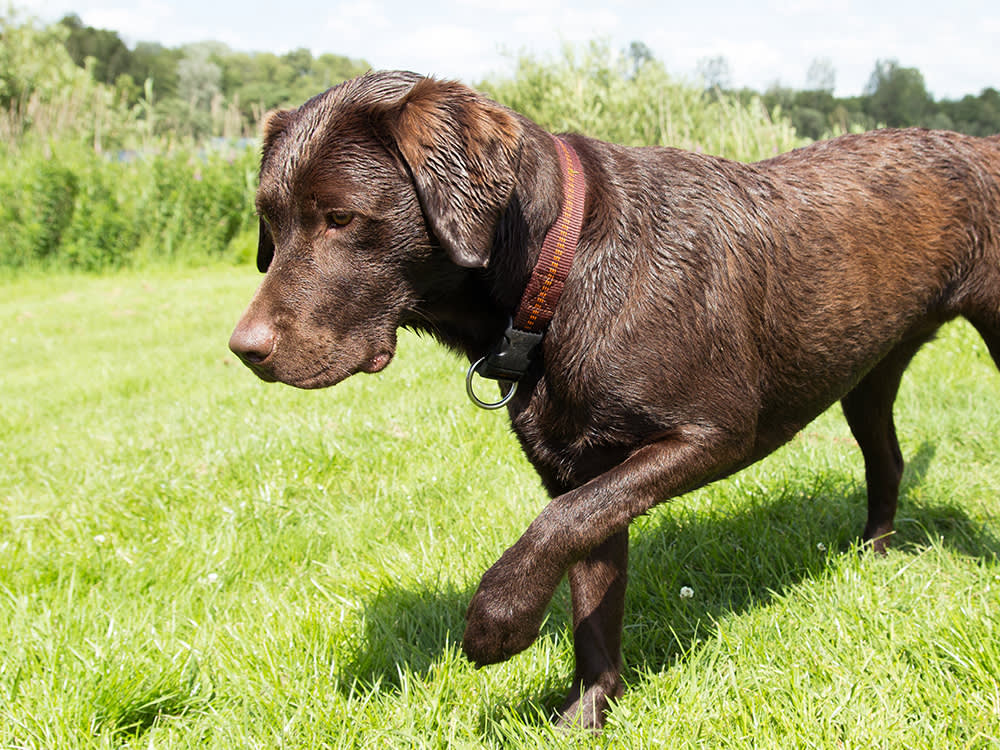
Share Article
“I think I have heartworm,” said no dog ever. Sadly, our pets can only let us know they’re sick by showing us symptoms: coughing, sneezing, itching, limping…the list goes on. Just as you take supplements to stay young and play Sudoku to stay sharp, preventive pet care is key to catching health concerns early on — before they spiral into a more serious (and costly) issues. Or, better yet, preventing them altogether.
“Preventive care is an investment,” says Dr. John Iovino. “Put in a little bit of energy — like getting your dog or cat vaccinated and being aware of diseases in your area — and you’ll get back a lot in the future.” The first step in preventive care is signing up for pet insurance. After that, here are seven preventive measures you can take to keep your pet as healthy as can be.
1. Annual Exams and Bloodwork
Dogs and cats age faster than we do, so it follows that they should get check-ups more often too. Puppies and kittens mature quickly and are considered teenagers by the time they’re one year old. As such, they need to see a vet a handful of times in their first years of life to receive vaccines and ensure they’re meeting their growth and developmental milestones. Even healthy adult dogs should see a vet for a wellness visit at least once a year, preferably twice. Physical exams can detect heart murmurs, enlarged lymph nodes, enlarged or shrunken kidneys, skin issues, and more. And what can’t be discovered by hand can be screened for by diagnostic testing such as fecal tests, urinalysis, and blood tests which can detect organ malfunctions early on. If your pet is a senior, you should consider biannual bloodwork so nothing gets past you or your vet.
2. Vaccines
Cheap, easy, effective. “There’s a set of the most significant diseases for dogs and cats and we’ve had ‘core’ vaccines for all of them for years,” says Dr. Iovino. “The rabies vaccine is required by law, but we highly recommend core dog vaccines that protect against distemper, hepatitis, and kennel cough in just one shot. If you live anywhere in the Northeast, get the Lyme vaccine. If your dog hangs out with other dogs at dog park s or daycare, get the Bordetella vaccine.” Core cat vaccines include feline distemper complex, feline leukemia, and feline chlamydial conjunctivitis — outdoor cats are especially at risk. Most require boosters, but all are very cost effective.
How much do you spend on your pet per year?

3. Parasite Prevention
Heartworm
“You should protect your pet year-round for heartworm,” says Dr. Iovino. “Heartgard is an affordable, monthly chewable tablet, although the company ProHeart makes injections that can cover them for a year.” The first signs of the illness aren’t always obvious to people — exercise intolerance, coughing, trouble breathing — but dangerous if missed. “I’ll see some animals come in who are in heart failure — they need hospitalization, maybe a specialist, or might be too sick to even handle treatment.”
Fleas and Ticks
Flea and tick preventative medications are often confused with heartworm preventives. While some brands are indeed all-in-one and protect again all these parasites, there are myriad flea and tick preventative options on the market. There are meat-flavored chewables like Nexgardopens in new tab for dogs and topical solutions like Revolutionopens in new tab for outdoor cats. Bravectoopens in new tab comes in chewable form for dogs and topical form for cats. Whichever form of flea and tick prevention you choose, it’s far easier than treating a pet who has contracted a flea allergy or tick-borne disease such as anaplasmosis and Lyme.
4. Early Detection and Diagnosis
Itching
If your pet is itching a lot, don’t assume they have fleas. Chronic scratching can signal environmental allergies which can make a dog or cat very uncomfortable. (It’s not very comfortable to witness, either.) Dr. Iovino says, “If left untreated, scratching can lead to hotspots, infections, and, in a lot of cases, tapeworms” — conditions that require antibiotics, prescription shampoos, steroids, or stronger immunotherapy interventions.
Lumps
“In our culture, we’re used to panicking when we find a lump,” says Dr. Iovino. In cats and dogs, a lump could be as innocuous as a bug bite, bruise, ingrown hair, or fatty deposit. Or, it could be the start of something as serious as cancer. “It’s easy for a vet to rule a lot of things out, but it’s very hard to do it just by looking. If the lump is under the skin and feels hard like a marble or golf ball, the only way to know what’s going on is to do some testing.” A fine-needle aspirate can be done in-house at your vet’s office and reveal if the material that makes up the lump is harmless or dubious. If the latter, as is the case with pet parents, early detection is everything.
Limps
“It takes a really trained eye to notice a limp and know what’s going on,” says Dr. Iovino. Dogs and cats may limp from muscle strain or injuries to their paw pads. No big deal. They may also limp from arthritis, fractures, dislocated hips, or ACL tears. Now you’ve got a problem. A tracking device like a Whistle Switchopens in new tab* can help monitor pet behaviors, including activity levels — like a canine Fitbit. “A vet I work with, Dr. Aletha Carson, noticed something was off with her dog but couldn’t tell what it was,” Dr. Iovino recalls. “Just by looking at the device’s data, she saw a significant enough drop in physical activity to warrant taking x-rays, and she was able to catch a partial ACL tear before it became a bigger problem.”
Lethargy
If it’s out of character for your dog to be sluggish or your cat to sleep even more than usual, something could be up. “If your pet isn’t old and it isn’t really hot out, lethargy needs to be investigated — especially if there’s anything else going on as well, like they’re having trouble eating, drinking, or going to the bathroom,” says Dr. Iovino. “These are some of the basic ways in which animals communicate distress.”
Vomiting or not eating
“If your pet vomits once, they might have eaten something that didn’t agree with them,” says Dr. Iovino. “But if your dog or cat is throwing up a lot, a toxin or even kidney failure could be to blame. There’s no way for us to know without examining them.” We humans are hungrier some days than others, but animals tend to eat what food is in front of them (hence, the vomiting). So if your dog or cat is not eating, there are a few reasons why you should be concerned, from anorexia to liver disease to cancer. “Just like sleeping or going to the bathroom, if there’s a noticeable change in normal behaviors, it’s a good idea to have them seen by a vet as soon as possible.”
5. Dental Care
Excessive drooling, bad breath, chewing on just one side — all signs that can indicate that your pet has dental issues. Periodontal disease is actually the most common disease in dogs, affecting more than 85% of dogs over the age of three. A cracked tooth in particular — which can be caused by something as seemingly harmless as chewing a bone — needs to be caught early. “I once treated dog who had been living with a cracked molar for ages,” recalls Dr. Iovino. “[By the time I saw them] it had already developed an abscess, a pocket of infection in the cheek, which required antibiotics and surgery — and caused a whole lot of stress and expense. Tragically, we see this pretty often.” Cats aren’t off the hook, either — they are prone to gingivitis and periodontitis. Veterinary dentists recommend brushing your pet’s teeth daily to keep plaque, tarter, and more serious issues at bay.
6. Weight Maintenance
Being overweight can lead to health issues from diabetes to heart disease for our pets. Overweight cats and dogs are also more prone to arthritis as their joints struggle to support the extra pounds. The Association for Pet Obesity Preventionopens in new tab reports that 60% of cats are overweight or obese. Your vet will rely on a visual assessment and Body Condition Scoring Systemopens in new tab, and let you know if your pet should lose (or gain) any weight.
7. Spaying or Neutering
Spaying or neutering your dog or cat can not only help the overpopulation problem; it has health benefits too. Neutering a male animal can prevent prostate and testicular cancers; spaying a female animal can prevent breast cancer and pyometras (a serious infection of the uterus). Kittens are cute but a cat in heat? Not so much.
* Whistle is a Kinshipopens in new tab brand. We think their products are pretty cool, but we don’t play favorites. So, when a product has family ties, we’ll be real with you.

Chris Norris
Chris Norris is a writer, reporter, author, and longtime companion to West Highland Terrier Gus, recently departed but intensely loved. He has written for The New Yorker, New York Magazine, The New York Times Magazine, Rolling Stone, GQ, Details, and NPR’s All Things Considered, and is the co-author of Tao of Wu. He lives in New York City with his wife and 10-year-old son.
Related articles
![Brown terrier dog scratching its ear outdoors]()
Relief for Your Dog: Discover Effective Solutions for Their Seasonal Allergies
A vet explains why environmental allergies flare up and what to do about it.
![black scruffy dog wearing cone recovering from spay surgery]()
Everything You Need to Know About Spaying and Neutering Your Dog
A vet’s take on why it’s a smart choice. Snip, snip!
![A vet examining the neck of a small dog on the examination table]()
Lymphoma Cancer in Dogs: What You Need to Know
Find out what causes lymphoma in dogs and how you can help your pup.
![Person holding a mix breed dog talking to veterinarian about their concerns.]()
8 Things Your Veterinarian Wishes You Wouldn’t Do
Common vet pet peeves, if you will.
![A woman in a bright yellow-orange sweater holding a striped kitten in one hand and a credit card in the other while using her laptop in front of her]()
How to Get Help With Vet Bills for Dogs Who Need Surgery
Worried about the cost of making your pet feel better? Help is on the way.
![cat and dog laying on bed together]()
What’s the Deal With Pet Insurance?
It covers your pet so you can get that broken leg fixed—while keeping your wallet happy.



